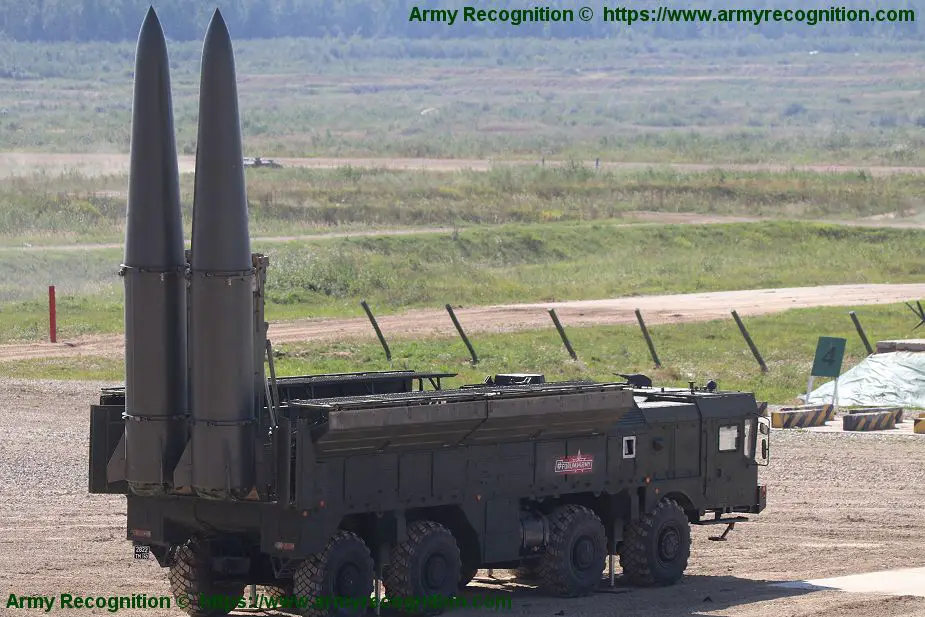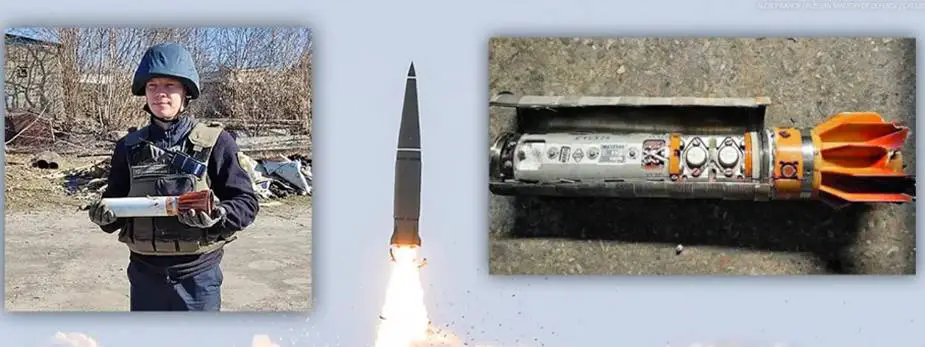Breaking news
Russian Iskander-M ballistic missiles unveil secret decoy capability in Ukraine war.
According to Thomas Newdick in The War Zone, Russian Ground Forces Iskander-M short-range ballistic missiles (NATO designation: SS-26 Stone) have been using an apparently previously unseen decoy, in an effort to spoof Ukrainian air defenses. The missile has so far seen extensive use in the conflict, the Pentagon having assessed that as many as 100 were launched in only the first hours of the Russian invasion on February 24. It is likely that the Iskander-M systems have been releasing these decoys in response to being illuminated by air defense radars. According to the New York Times, “the use of the decoys may help explain why Ukrainian air-defense weapons have had difficulty intercepting Russia’s Iskander missiles”.
Follow Army Recognition on Google News at this link

Iskander-M mobile ballistic missile TEL Transporter Erector Launcher unit in firing position at Armya defense exhibition near Moscow, in August 2018. (Picture source: Army Recognition)
Thomas Newdick writes that penetration aids, or PENAIDs, of a broadly similar kind, have previously been associated with much longer-range strategic missile systems, namely intercontinental ballistic missiles (ICBMs). However, these decoy munitions now point to Russian efforts to ensure that its short-range battlefield ballistic missiles, too, are better able to defeat increasingly sophisticated anti-ballistic missile (ABM) defenses. What’s especially surprising is that Russia has now revealed this potentially significant aspect of the Iskander-M, one that it had previously managed to keep under wraps during the conflict in Ukraine where it isn’t likely even needed.
Photos of the then-mysterious decoys, originally identified as submunitions of some kind, began to appear earlier this month, Thomas Newdick reports. They were brought to wider attention by Collective Awareness to Unexploded Ordnance, or CAT-UXO, an organization that brings together the explosive ordnance disposal (EOD) community in order to collate information and awareness. Roughly 16 inches long, dart-shaped, and with white bodies and orange tails, the purpose of these objects was at first unclear.

Photos of the then-mysterious decoys, originally identified as submunitions of some kind, began to appear earlier this mont (Picture source: CAT-UXO)
An unnamed U.S. intelligence official has told the New York Times that these items are “previously unknown decoys”. The decoys are deployed by the 9K720 Iskander-M’s solid-fuel 9M723 ballistic missiles that, according to official figures, have a range of 310 miles, although there is evidence that they can fly farther than that. The decoys, according to the U.S. intelligence officials, help the missiles evade air defense systems since they are able to “trick air defense radars and fool heat-seeking missiles”. Apparently, a single 9M723 can be loaded with at least six of the decoys, which slot into tubes located at the base of the missile body.
The decoys appear to feature at least two different kinds of countermeasures: a jammer to disrupt radar-frequency emitters, and a decoy heat source to confuse infrared-guided missiles. It’s also possible that the body of the decoy itself serves a spoofing purpose, by creating an enhanced radar signature that might trick radar operators into thinking they are looking at a real missile or something else entirely. Moreover, not only does a decoy like this present a hurdle to potential interceptor missiles, but it also provides discrimination challenges for defenders who have to determine where the real missile is before attempting an intercept.
The intelligence official speaking to the New York Times also explained that the decoys are activated once targeted by air defense systems, suggesting that they may only be released once the Iskander-M missile determines that it is under threat. What isn't clear is if U.S. intelligence knew about this capability beforehand, and, if so, to what degree of detail.
There is strong evidence to suggest the decoys may be known by the Russian GRAU index as 9B899, which is seen written on at least some of the examples recovered. Michael Duitsman, a research associate at the James Martin Center for Nonproliferation Studies at the Middlebury Institute of International Studies in Monterey, California, has also found apparent further details about the decoys, including two companies that may be involved in their manufacture, thanks to that nomenclature.
The Iskander-M can launch its missiles using depressed quasi-ballistic trajectories and they are reportedly capable of significant maneuvering in flight, presenting major challenges even for opponents with more robust missile defense capabilities.
While the Iskander-M can carry an alternative nuclear warhead, the missile has been used in recent years as a conventional warhead delivery system, and it’s designed for battlefield rather than strategic use, Thomas Newdick recalls. With that in mind, the Iskander-M may even be the first conventionally armed ballistic missile to incorporate decoys of this kind.

The decoys launched by an Iskander-M ballistic missile appear to feature at least two different kinds of countermeasures: a jammer to disrupt radar-frequency emitters, and a decoy heat source to confuse infrared-guided missiles. (Picture source: CAT-UXO, via The War Zone)




























